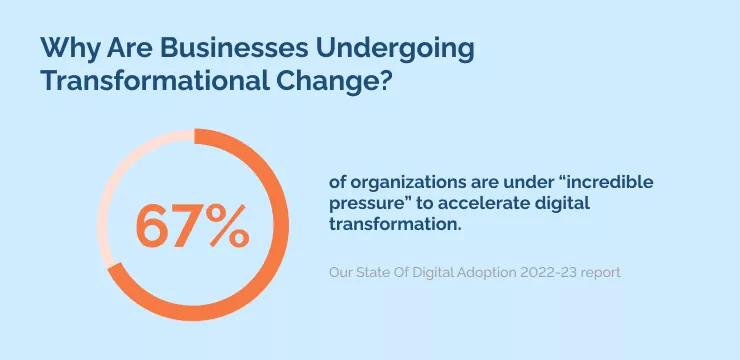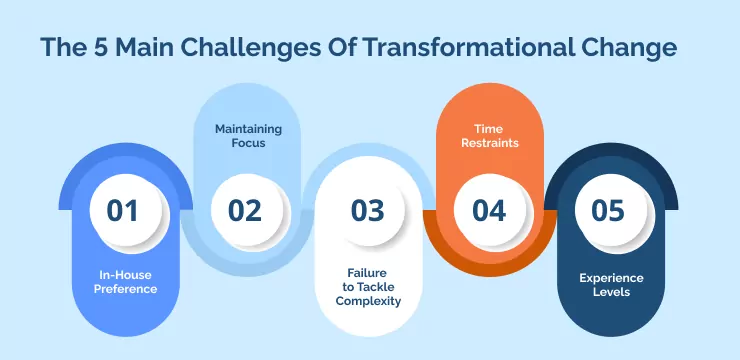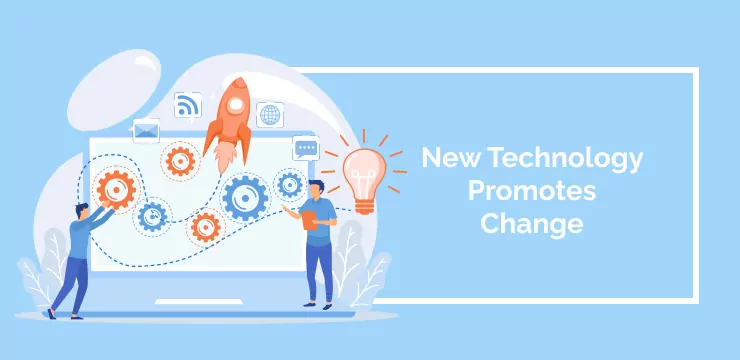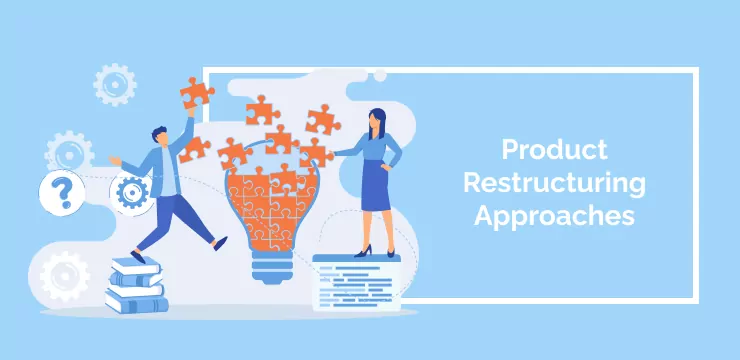
Many areas of managing change are not adequately discussed online but are essential to organizational development. Transformational change management is one of these areas, and examples help show what this concept is and how it works in practice to ease the challenges of the digital learning curve for change projects.
This article will explore transformational change management examples in 2023 through the following topics:
- What is change management?
- What is transformational change?
- Why Are Businesses Undergoing Transformational Change?
- The 5 Main Challenges Of Transformational Change
- Transformational Change Management Examples
Let’s begin with a definition of change management.
What Is Change Management?
Change management is the support leaders give their staff undergoing major changes as part of the company’s new direction within a digital transformation. Change projects usually involve hundreds or thousands of staff undergoing the complex, stressful experience of learning new technologies.
Change management helps change leaders understand and work with these challenges to help staff make transformation initiatives succeed as the organization heads in a new strategic direction.
What Is Transformational Change?
Transformational change is when a company changes its operations and is a form of organizational change. It happens because all companies must constantly improve their business processes and operations with change initiatives. They do this to compete in the marketplace against their peers, continually researching and investing in new technologies as part of their transformational changes.
Why Are Businesses Undergoing Transformational Change?
Our State Of Digital Adoption 2022-23 report shows that 67% of organizations are under “incredible pressure” to accelerate digital transformation. Why is this? For the answer, we must turn to the constant evolution of technological tools designed to improve business processes. When a few large companies utilize technologies such as the cloud, adaptive AI, or super apps, others must invest or lose revenue.
When organizations face crises or seek to enhance their competitive position by adapting and taking advantage of new business models and technologies, they often turn to transformational change theory. This approach allows them the opportunity for transformation to remain relevant in the ever-evolving market.
The 5 Main Challenges Of Transformational Change
Gartner projects global IT spending to total $4.6 trillion in 2023, an increase of 5.1% from 2022. A large proportion of investment will be into new technologies requiring transformational change that presents enormous challenges for staff to implement.
Being aware of the challenges of transformational change to tackle them individually ensures lower financial risk, improved employee retention, and overall success. The first of these challenges is in-house preference.
1 In-House Preference
A company’s choice to pursue a designated change project requires selecting an individual with strong leadership capabilities and familiarity. The chosen sponsor should possess in-depth knowledge of how aspects of the business function.
Although it is helpful to hire and promote amongst your existing pool of staff as part of the corporate culture, there are drawbacks when it comes to transformation, as it is challenging for existing staff to form new perspectives. For some of the transformation team, consider external hires or consultants to provide unique points of view on your transformation to ensure you are moving toward long-term, transformational change.
2 Maintaining Focus
Every year, companies start projects that can help them be successful. But soon, something else comes up, and they must stop working on their project as they must focus on the new issue instead.
This lack of focus devastates the company culture, furthering an acceptance that staff does not need to complete tasks. When this behavior is accepted, it can be tough to reverse the damage to internal structures, such as the company structure or the operating model. To ensure your company thrives, maintaining focus must become priority number one.
3 Failure to Tackle Complexity
Initially, the project seemed to be going positively as you changed company structures. But then, it took several unexpected turns and ultimately exceeded its scheduled timeline by months. Despite producing unsatisfactory results that didn’t meet initial objectives, the company nonetheless justified these outcomes due to their belief in higher complexity than initially considered.
This predicament demonstrates the necessity of a well-defined and accessible project scope. If a change project does not have goals, it will make measuring milestones and timelines difficult – if not impossible. To guarantee that the project remains on track, stakeholders must set clear and straightforward parameters for success, ensuring that leaders align everyone to the same vision of progress.
4 Time Restraints
An organization gives an individual with an already strenuous workload a change project, but they are passionate and driven to succeed. With unwavering faith that the business will provide full support, this employee eagerly accepts the challenge and begins weekly meetings for all parties involved to achieve desired outcomes.
Regrettably, this is a familiar tale. Simple projects require around twenty hours of work per week, and more significant transformation efforts need even greater input. Complex tasks challenge organizations to the limit, necessitating full-time commitment from the project sponsor. Always plan how much time each project will take to ensure success.
5 Experience Levels
As your company begins its journey with a new set of values and rules, it is essential to remember the limitations of leaders. While they may have many generic solid leadership qualities, they might not possess adequate experience or subject matter expertise necessary to manage a specific change.
Transformation initiatives often require constant supervision; thus, if someone unfamiliar with the topic is involved in managing them, then there’s always a chance for derailment. Ensure you include the right people in the change management leadership and hire external transformation consultants where needed.
Transformational Change Management Examples
Looking at transformational change management examples will help you see how this concept works and how you can practice it successfully. The first examples explore how new technology promotes change.
New Technology Promotes Change
Throughout history, failure to embrace technological innovations has brought about the closure of many organizations. For instance, as automobiles became the primary mode of transportation, those who crafted parts for horse-drawn carriages had to find new ways to make their products or a new business model relevant.
In late 2020, IBM stated its resolution to make drastic modifications by splitting into two distinct companies. NewCo was devoted to helping their long-standing customers migrate information onto the cloud, and IBM itself aimed at advancing new technologies such as Artificial Intelligence.
The publishing industry is on the brink of a revolutionary transformation, as desktop publishing has opened up opportunities for smaller publishers to succeed. Nowadays, we can easily find book publishers, newspapers, and magazines selling content online.
Product Restructuring Approaches
Companies can also redesign existing products or services to stay ahead of the curve. Consider a restaurant owner whose customer base is aging; they might tap into new markets by adopting food delivery platforms and offering more healthy meals, craft beer selections, and pickup options to appeal to younger customers.
In 2017, the tennis world saw an insurgence of pickleball players and a subsequent decline in their numbers. To combat this shift, the Professional Tennis Registry launched the Professional Pickleball Registry to educate leaders on how to teach others about pickleball. This product restructuring effort has been highly successful in helping older generations engage in this sport.
Market Repositioning Needs
For some companies, a change of direction is necessary to stay afloat or rebrand. Many companies refer to this action as “pivoting.” Countless influential organizations use it, so it is at risk of becoming obsolete. One such example is YouTube, which initially catered only to dating purposes before it transformed into what we know today – the most extensive online video service provider.
Changes in Key Leadership Roles
Transformational leaders can revolutionize an organization by inspiring employees and challenging existing structures. By combining ambition with a clear vision, these leaders can create comprehensive transformations that lead their companies toward success.
Retired IBM CEO Lou Gerstner faced a daunting task in 1983: the company had racked up $8 billion in losses and was on the brink of bankruptcy. Rather than go down with the ship, he changed IBM’s rigid and inflexible culture into one that encouraged teamwork, ingenuity, and innovation.
Thanks to this determined and creative approach, we know that under Gerstner’s stewardship (and eventual success), IBM is now an industry leader for businesses worldwide.
Transformational Change Management Is All About People
Transformational Change Management is a complex and ever-evolving concept in the modern business landscape. While the change process may appear daunting initially, you can understand the different components of transformational change management and achieve success by reflecting on potential challenges and their solutions.
As your organization looks ahead toward the remainder of 2023, remember that embracing the challenges of transformational change management is all about people, not technology. Ensure that employees and stakeholders remain motivated through critical decisions involving significant changes. By taking one step at a time, you will enjoy countless successful outcomes as your organization navigates turbulence while executing transformational change.
Tristan Ovington
Tristan Ovington is a professional senior writer and journalist, specializing in providing expert insights on various topics such as digital adoption, digital transformation, change management, and Cloud apps. He delivers his knowledge through accessible online content that is data-driven and presented in a friendly tone, making it easy for readers to understand and implement.













